A Guide to Understand Parts of a Flower with Diagram
Flowers are an essential part of a tree, helping them continue their generations with the fertilization process. Though the reproduction process of flowers is complicated, learning about the segments of the flower can help a student understand it. They can use parts of a flower diagram to have an apt idea about the different parts of the flower and their functions. The students must use the EdrawMax Online tool to create high-quality parts of a flower diagram.
1. Parts of a Flower
Flowers are the parts that have the reproductive parts of a tree. The flower ensures that pollination occurs and the species of the tree survives. As for pollination, many trees depend on pollinators like birds and butterflies. They have flowers with a sweet smell and bright colors. On the other hand, the flowers having wind as pollinators have a light color and a slight odor. The flowers are different from each other. Based on their sections can be classified as complete and incomplete flowers.
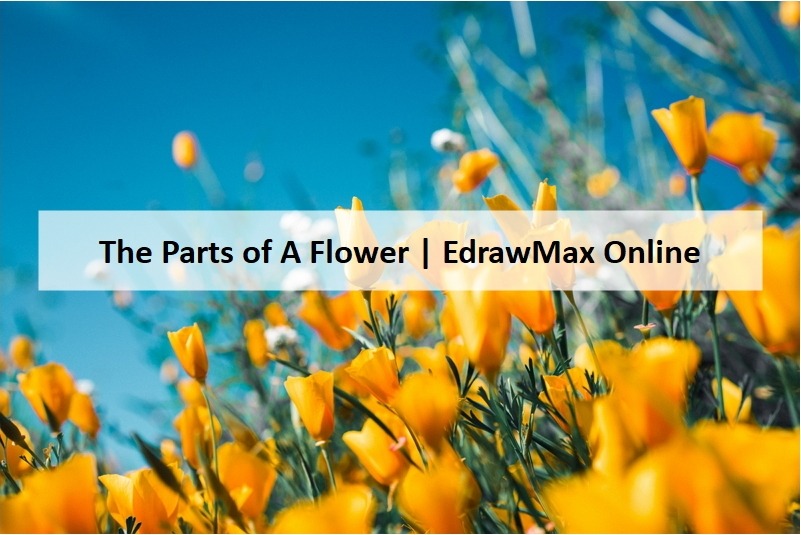
1.1 The Structure of a Flower
- Petal:
- The central function of the petals is to attract the attention of the pollinators like birds and butterflies, who can help in the pollination process. They also cover the reproductive parts of the plant.
- Sepal:
- Sepals act as the covering of the internal flower since it develops into a bud and protects it from possible harm.
- They act as the bract around the petals of the flower. They also work to attract pollinators.
- They also prevent a flower from drying.
- Peduncle:
- Peduncle works as a support system for the flower as it stays in an elevated position to attract the pollinator.
- Receptacle:
- The function of the receptacle of a flower is to support the weight of the whole flower. It holds the weight of fruits as the flower transforms into it.
- Pistil:
- Stigma: The tip of the pistil is called the stigma. It collects the pollen on its sticky tip to start the process of fertilization.
- Style: It is the long stalk structure that holds the stigma and supports it.
- Ovary: Ovary is present at the bottom part of the flower, and they have ovules. This ovary turns into the fruit after maturation, and the ovules become the seeds.
- Function: It gets the pollen and participates in fertilization.
- Stamen:
- Anther: The top part of the stamen produces pollen and is known as another.
- Filament: Filament is a stalk-like part that holds the anther. It stays attached to the flower.
Petals are the bright color layer of the flowers that cover the reproductive parts of the tree. They can be of different shapes, sizes, and colors. In some flowers, the petals are separated, while for others, they are joined together. The petals may have bright colors or white colors. They make the flowers look pretty.
Function:
This is the exterior part of the flowers. They are modified leaves, and hence they are green in color. However, depending on the nature of the plant, the sepals can be of any color. They develop first as they emerge and create buds which later transform into flowers. A flower may or may on have sepals.
Function:
A flower grows on top of the flower stems or peduncles. They are the flower stalks on top of which there is a flower arrangement. The internode between the receptacle and the bract develops into the peduncle. It happens for those trees where a flower blooms singly.
Function:
A receptacle is present at the top part of the peduncle to support the weight of the flower. The primary segment of the flower is positioned on it. There is an enlargement in this part to hold the flower weight.
Function:
The pistil of the flower holds the female reproductive parts. It is present at the center of the flower, and the flower petals protect these parts. It may look like a knob, present in the middle. Pistils have three distinct parts, stigma, style, and ovary.
It is the male part of the flower, and they are generally present at both sides of the pistil. The stamen consists of two parts: anther and filament.
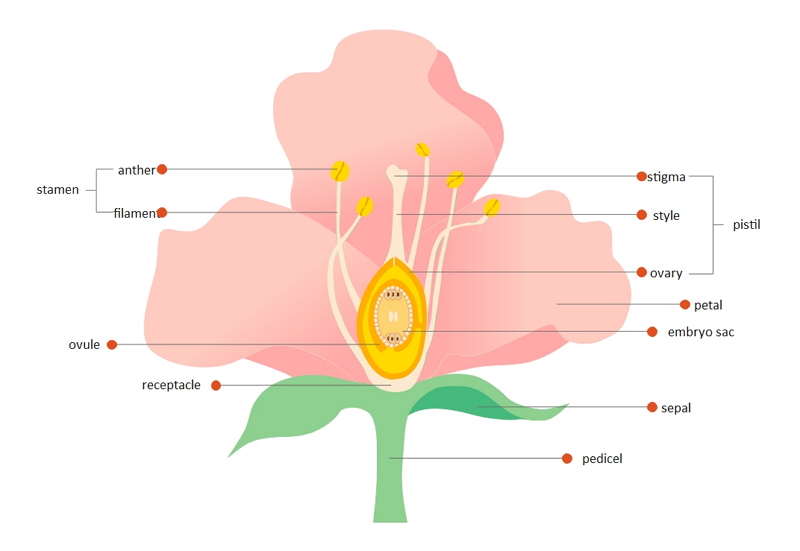 Source:EdrawMax Online
Source:EdrawMax Online
1.2 The Classifications of Flower
- Complete and incomplete flowers:
- Perfect and Imperfect flowers:
- Monoecious and Dioecious:
If a flower has all four main parts, petals, sepals, pistil, and stamen, they are called complete flowers. Example: Hibiscus. If any of these parts is absent, then that is called an incomplete flower. Example: corn.
If a flower has both the male and female reproductive parts, stamen, and pistil, they are called perfect flowers. They may have any other major part absent, but they must have both the male and female reproductive parts. Example: Orchid.
When a flower has either male or female reproductive parts present, it is an imperfect flower. Example: Cucumber.
If a tree has both male and female imperfect flowers, one with functional stamen and another with the functional pistil are monoecious. They are self-pollinating and may bear fruit.
In dioecious plants, one plant has all-male flowers with functional stamen while another plant has all-female flowers with the functional pistil.
2. How to Draw the Parts of a Flower Diagram?
The students must use parts of a flower diagram to learn about the flowers and their reproductive cycle.
2.1 How to Create Parts of a Flower Diagram from Sketch
The students can create the pictures by hand, but the process is complicated. For that, they need to follow these steps:
Step 1: To begin with it, the students need to draw a stalk with a button-like top and a swollen part at its bottom. Then they have to draw a straight line from top to bottom. They need to draw a circle inside the swollen part at the bottom where dots are marked. This part is the pistil.
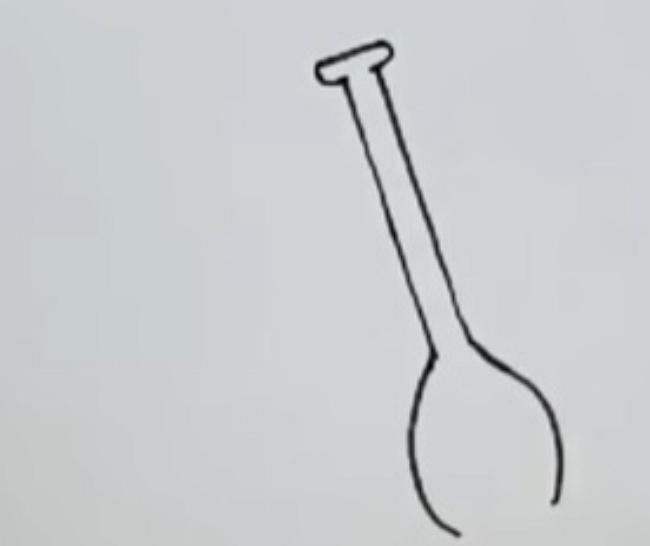
Step 2: Draw another swollen part from under the previous one, which looks like the stem. Draw tiny leaves on the side of this swollen bottom part.
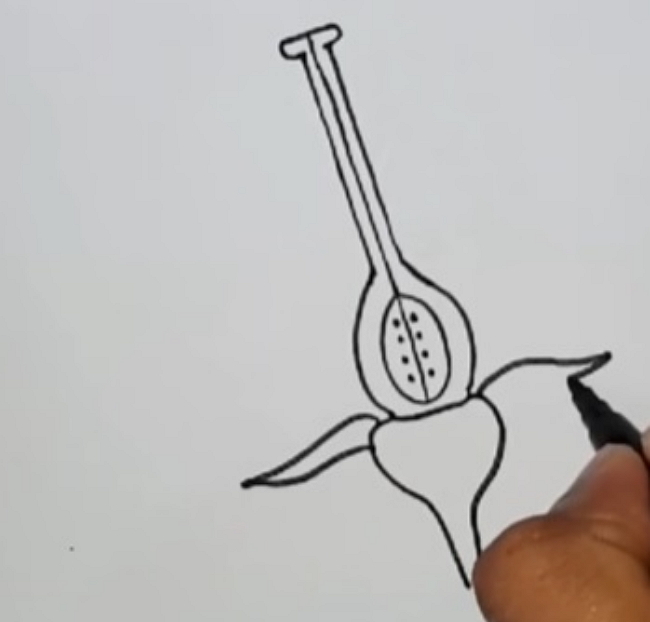
Step 3: Now draw four curved lines at the sides of the pistil, which have double-layered circle-like heads. They are the stamens.
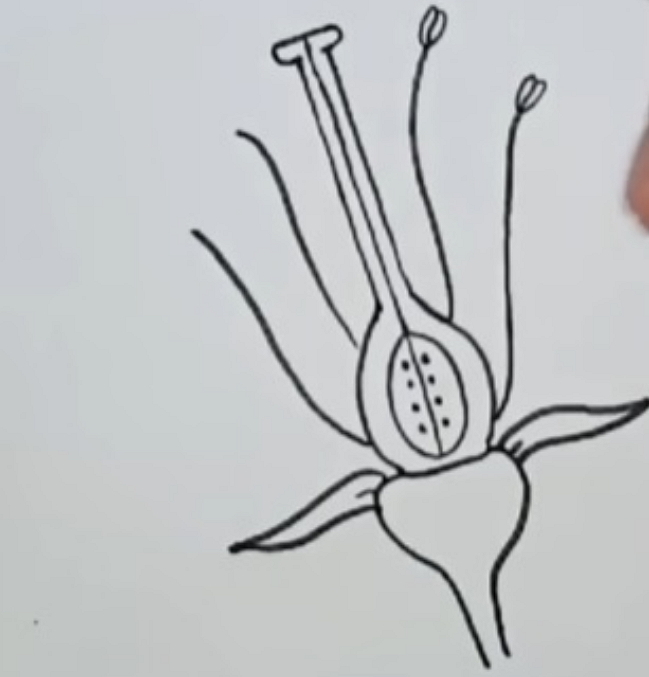
Step 4: Draw three petals at the back of the stamens and the pistil.
2.2 How to Create Parts of a Flower Diagram Online
It is time-consuming and challenging to create parts of the flower diagram by hand. Therefore, the students must use the EdrawMax Online tool, which is user-friendly. Here are a few simple steps which they can follow to create a part of a flower diagram with the help of this tool :
Step 1: The tool is easy to use, and the students can work on this tool by opening the same and then opening New. They have to select the Science and Education tab. The students can also use this tool to create different types of education-related diagrams.

Step 2: The students can then go to the Biology section, where they will find a wide range of high-quality diagrams related to biology. The students can now select the parts of a flower diagram and then modify it as per their requirements.

Step 3: After selecting the template they require, the students should modify it as per their choice. The tool gives the students some hassle-free options to edit their diagrams. They can work on those images according to their preference to create a high-quality flower diagram.

Step 4: After finishing their diagrams, students can save them in any file format they want. They can also export it to use in their lessons.

3. Facts about the Parts of a Flower for Kids
There are some facts about the parts of a flower. These tips may help you and the students to know flowers further.
- Bees, insects, and birds are pollinators, and they collect the pollen from the anther of the flowers.
- For fertilization, the pollens get to the ovule through the style of the stamen.
- There is an ovule present in the pistil, where the fertilized eggs develop into seeds.
- Flowers get support from the stem, which also supplies the necessary nutrients.
- When a flower is in bud condition, the sepals protect it from external threats. In a blooming flower, sepals hold the petals and support the flower.
- In the ovary of a flower, the unfertilized eggs get combined with pollen. It is called fertilization.
- Petals have pretty colors and smell to attract pollinators.
4. Conclusion
It is essential to use a diagram to learn about the different flower parts and their functions. It can help the students to understand how reproduction in plants works. It is tough to create the parts of a flower diagram by hand. To make high-quality parts of a flower diagram, the students must use the EdrawMax Online tool.
In conclusion, EdrawMax Online is a quick-start diagramming tool, which is easier to make flower diagram and any 280 types of diagrams. Also, it contains substantial built-in templates that you can use for free, or share your science diagrams with others in our template community.


